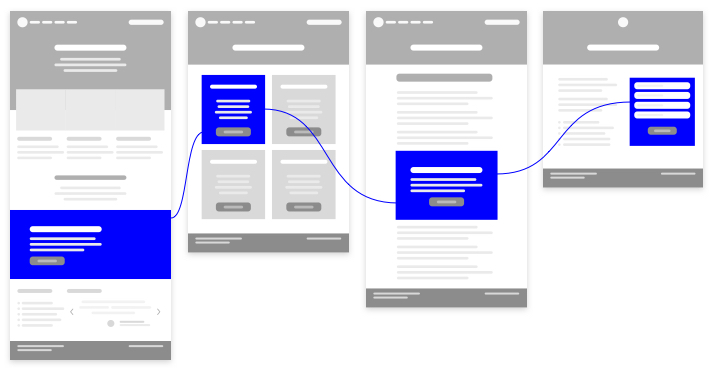What makes a good industrial website? What does “good” even mean? Are good websites informative? Are they easy to use? Are they clean and visually appealing? Do visitors find what they’re looking for?
Those are all necessary elements for good B2B websites—the flesh that hangs on the bones of your business’s most important asset.
But those elements alone aren’t enough when the goal behind your site is to generate contacts and leads. To do that, you need to take an important step that drives the design, construction and maintenance of your site going forward.
User flow maps
They are what they sound like: routes showing how visitors ideally travel through a website from an initial starting point —usually a piece of content you’ve created that the visitor found in a search engine— to a terminus where a conversion (hopefully) takes place.
There can be hundreds of these on a given site, but they basically break down into segments based on a site visitor’s stage in the buying process.
Remain vigilant and harbor the user flow map mentality at all times. The opportunities to turn your industrial website into a conversion machine are endless.
Top-of-funnel buyers are in the initial research phase of their journey. User flow maps for these visitors are the simplest: They land on a blog post and like it enough to click the “subscribe” button to join your newsletter.
Middle-of-funnel buyers are still researching, but they want more detailed information. Good user flow allows the visitor the opportunity to learn more on the subject they read about in a blog post. It usually comes in the form of a call-to-action to download a white paper, a guide or other premium content.
Buyers deeper in their journey have narrowed their searches and may want to learn more about your company. From their initial landing page, they may be directed to your “About” or “Home” pages. Those pages may feature case studies or testimonials showing your product or service at work in the field.
Note that the above routes are far from fixed. You can make more complex and varied user flow maps, but the point is that an industrial website designed to convert must have these ideal paths of travel ingrained in its DNA.
How user flow maps help
Maybe the best way to illustrate how user flow maps enhance websites is to talk through the questions you won’t be able to answer if you don’t use them.
What discovery-stage content will you create to attract the audience you’re trying to reach? What action do you want someone to take at the end of their visit? Is your site linear and progressive or a journey without a destination?
The lack of a detailed plan for how visitors travel through your site is likely to spawn the “What now?” questions that often render websites digital dead weight instead of integral business generation tools. You can learn more about other critical components of website pre-construction here.
Think in retrospect, too
User flow maps are critical to the beginning stages of any new website build or the overhaul of an existing site. But established sites can still benefit from real-time user flow tinkering to take advantage of trends.
For example, say you wrote a blog post that explains there’s more to widget design than meets the eye. The post is two years old, but it’s optimized for search and it’s earning big time traffic.
Is there a call-to-action on the page? Is there someplace else further down the funnel you can direct this volume of visitors? Can you write a new case study showing how your business enhanced widget design with stellar results for a client? Can you tinker with the closing paragraph of the post to invite visitors to request a quote or consultation?
Remain vigilant and harbor the user flow map mentality at all times. The opportunities to turn your industrial website into a conversion machine are endless.
Other considerations
Effective user flow mapping is all well and good, but it’s only one of the many things you need to do right for you industrial website to convert. Here are some other ideas you need to consider:
- Your content has to be good. The most intelligent user flow maps are useless if the content you build around them isn’t optimized for search and doesn’t provide the information your site’s visitors are seeking. You must make a good first impression, and research shows you only have a few seconds to do that before someone checks out.
- Production value has to be high. Web users can detect BS a mile away, and relying on cheap templates and stock photography will earn you nothing but scoffs from users. Take the time to invest in professional photography and experienced web design and development so that the digital space you create is worthy of your visitors’ time.
- You do need user flow maps, but you might not need a from-scratch site rebuild. If it ain’t broke, don’t fix it. And if it’s only a little broke, it’s cheaper and easier to fix it instead of just junking the whole thing. We love building websites, but we won’t recommend you go down that road unless we believe you really need it.
It’s a team sport
Creating user flow maps and using them to inform what your industrial website contains can work wonders, but it’s far from the only thing you should be doing. It’s just one part of a larger website planning process—something you can learn more about by reading our B2B website planning handbook.
